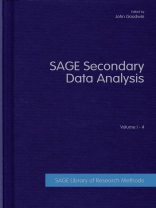One central and enduring image of the social science researcher is of an individual who commits a great deal of time to collecting original, primary data from a field of enquiry. This approach is often underpinned by a sincerely held belief that key research questions can only be explored by the collection of ever new, and ever greater amounts of data, or that already existing data are insufficient for researchers to test their ideas. Yet such an approach to social science research can be problematic not least because the collection of primary data can be an expensive, time-consuming, and even wasteful approach to social enquiry.
Secondary analysis can serve many purposes, as well as being a valid approach in its own right. However, despite its widespread application, secondary analysis is often undervalued or perceived to be the preserve of only those interested in the re-use of large-scale survey data.
Highlighting both the theory and practice of secondary analysis and the use of secondary sources, this collection considers the nature of secondary analysis as a research tool; reflects on the definitional debates surrounding terms such as secondary analysis, data re-use and restudies; illustrates how secondary analysis is used in social science research; and finally reviews the practical, methodological and ethical aspects of secondary analysis.
Volume One: Using Secondary Sources and Secondary Analysis
Volume Two: Quantitative Approaches to Secondary Analysis
Volume Three: Qualitative Data and Research in Secondary Analysis
Volume Four: Ethical, Methodological and Practical Issues in Secondary Analysis
Inhaltsverzeichnis
VOLUME ONE: USING SECONDARY SOURCES AND SECONDARY ANALYSIS
What Is Secondary Analysis? – Janet Heaton
Introduction to Secondary Analysis of Survey Data – K. Jill Kiecolt and Laura Nathan
Secondary Analysis and the Relationship between Official and Academic Social Research – Catherine Hakim
The General Household Survey as a Source for Secondary Analysis – Nigel Gilbert, Angela Dale and Sara Arber
Combining Registry, Primary and Secondary Data Sources to Identify the Impact of Cancer on Labor Market Outcomes – Cathy Bradley et al
Using Secondary Data in Marketing Research – Stephen Castleberry
A Project That Melds Web and Off-Web Sources
Secondary Research, New Product Screening and the Marketing Research Course – William Lesch and James Hazeltine
An Experiment in Structured Decision-Making
Secondary Data for Policy Studies – Wendy Young and Hosihn Ryu
Benefits and Challenges
Conducting Secondary Research – Bonita Kolb
Data Collection in the Urban Setting – Gregory Andranovich and Gerry Risposa
Introduction to Secondary Research – David Stewart and Michael Kamins
Secondary Data Analysis – Ernest Brewer
Official Statistics – Piergiorgio Corbetta
Using Other People′s Data – Theodore Greenstein
Secondary Data Analysis – Paula Devine
The Importance of Census and Other Secondary Data in Development Studies – Vandana Desai and Robert Potter
The Basic Language of Statistics – Rachad Antonius
VOLUME TWO: QUANTITATIVE APPROACHES TO SECONDARY ANALYSIS
Secondary Analysis of a Major Societal Experiment – Joseph Locascio
The Effects of Standardized Testing in Elementary Schools
Complex Sampling Designs and Statistical Issues in Secondary Analysis – Shawn Kneipp and Hossein Yarandi
Research Methodology – Rich Clark and Marc Maynard
Using Online Technology for Secondary Analysis of Survey Research Data – ′Act Globally, Think Locally′
Testing Mediation Using Multiple Regression and Structural Equation Modeling Analyses in Secondary Data – Spencer Li
Police Involvement in Child Protective Services Investigations – Theodore Cross, David Finkelhor and Richard Ormrod
Literature Review and Secondary Data Analysis
A Secondary Survey Analysis Study of African American Ethnic Identity Orientations in Two National Samples – Lauri Hyers
Neighborhood Effects in Temporal Perspective – Geoffrey Wodtke, David Harding and Felix Elwert
The Impact of Long-Term Exposure to Concentrated Disadvantage on High School Graduation
Community College Student Engagement Patterns – Victor Saenz et al
A Typology Revealed through Exploratory Cluster Analysis
Patterns of Substance Involvement and Criminal Behavior – Eric Sevigny and Phyllis Coontz
A Gender-Based Cluster Analysis of Pennsylvania Arrestees
Regional Differences in Labour Market Participation of Young People in the European Union – Anne Green, David Owen and Rob Wilson
Determining the Relative Importance of Predictors in Logistic Regression – Scott Tonidandel and James Le Breton
An Extension of Relative Weight Analysis
Women, Lifelong Learning and Transitions into Employment – Andrew Jenkins
Strong Families, Tidy Houses and Children′s Values in Adult Life – Eirini Flouri
Are ′Chaotic′, ′Crowded′ and ′Unstable′ Homes Really so Bad?
Race and Ethnicity and the Controversy over the U.S. Census – Margo Anderson and Stephen Fienberg
Identifying and Measuring Dimensions of Urban Deprivation in Montreal – Andre Langlois and Peter Kitchen
An Analysis of the 1996 Census Data
Disparities in Access to Care among Asthmatic Children in Relation to Race and Socioeconomic Status – Crystal Piper et al
Gender Differences in Predictors of Assaultive Behavior in Late Adolescence – Suyeon Park, Merry Morash and Tia Stevens
Measuring Interest Group Influence Using Quantitative Text Analysis – Heike Kl ver
Facilitating Content Analysis in Tourism Research – Svetlana Stepchenkova, Andrei Kirilenko and Alastair Morrison
When Less Is More – Bernhard Ebbinghaus
Selection Problems in Large-N and Small-N Cross-National Comparisons
Family Policies, Wage Structures and Gender Gaps – Hadas Mandel and Moshe Semyonov
Sources of Earnings Inequality in 20 Countries
VOLUME THREE: THE SECONDARY ANALYSIS OF QUALITATIVE DATA
Secondary Analysis of Qualitative Data – Tracy Long-Sutehall, Magi Sque and Julia Addington-Hall
A Valuable Method for Exploring Sensitive Issues with an Elusive Population?
Mobility Adaptations of Older Adults – Kathy L. Rush, Wilda E. Watts and Janice Stanbury
A Secondary Analysis
Women′s Empowerment in Pakistan – Maria Irma Bustamante-Gavino, Salma Rattani and Kausar Khan
Definitions and Enabling and Disenabling Factors: A Secondary Data Analysis
Exploring Complex Transitions – John Goodwin and Henrietta O′Connor
Looking back at the ′Golden Age′ of from School to Work
Through the Interviewer′s Lens – John Goodwin and Henrietta O′Connor
Representations of 1960s Households and Families in a Lost Sociological Study
Resistance and Adaptation to Criminal Identity – Nigel Fielding and Jane Fielding
Using Secondary Analysis to Evaluate Classic Studies of Crime and Deviance
Can We Re-Use Qualitative Data via Secondary Analysis? Notes on Some Terminological and Substantive Issues – Martyn Hammersley
(Re)-Using Qualitative Data? – Niamh Moore
A Reflexive Account of Re-Using Qualitative Data – Libby Bishop
Beyond Primary/Secondary Dualism
Linking Stress and Injury in the Farming Environment – Pamela Kidd, Ted Scharf and Mark Veazie
A Secondary Analysis of Qualitative Data
The Possibilities and Pitfalls of Doing a Secondary Analysis of a Qualitative Data Set – Pamela Hinds, Ralph Vogel and Laura Clarke-Steffen
Online Petitions – Helen Briassoulis
New Tools of Secondary Analysis?
Using Documents in Research – William Gibson and Andrew Brown
Using Documents – Ruth Finnegan
Secondary Analysis of Archived Data – Clive Seale et al
Types of Qualitative Secondary Analysis – Janet Heaton
Revisiting – Julie Mc Leod and Rachel Thomson
A Theoretical Understanding of Sickness Absence among Women Who Have Experienced Workplace Bullying – Sue O′Donnell, Judith Mac Intosh and Judith Wuest
Distinguishing the Trees from the Forest – Greg Guest and Eleanor Mc Lellan
Applying Cluster Analysis to Thematic Qualitative Data
VOLUME FOUR: ETHICAL, METHODOLOGICAL AND PRACTICAL ISSUES IN SECONDARY ANALYSIS
Ethical and Representational Issues in Qualitative Secondary Analysis – Sally Thome
Utilizing Data from a Lost Sociological Project – Henrietta O′Connor and John Goodwin
Experiences, Insights, Promises
Obtaining and Evaluating Data Sets for Secondary Analysis in Nursing Research – Ann Jacobson, Patti Hamilton and James Galloway
The Impact of Working with Disturbing Secondary Data – Ben Fincham, Jonathan Scourfield and Susanne Langer
Reading Suicide Files in a Coroner′s Office
Secondary Consumer Data – Mario Mazzocchi
Identifying What Data Must Be Collected – Roger Kaufman, Ingrid Guerra and William Platt
Evaluating Secondary Sources – David Stewart and Michael Kamins
Alternative Data Sources – Rosalind Dworkin
Locating Appropriate Data – K. Jill Kiecolt and Laura Nathan
Secondary Analysis – Leigh Burstein
An Important Resource for Educational Research and Evaluation
Qualitative Researchers′ Understandings of Their Practice and the Implications for Data Archiving and Sharing – Alex Broom, Lynda Cheshire and Michael Emmison
Using Large-Scale Databases in Evaluation – William Penuel and Barbara Means
Advances, Opportunities and Challenges
Large-Scale Survey Data in Career Development Research – Matthew Diemer
The Provision of Access to Quantitative Data for Secondary Analysis – Keith Cole, Jo Wathan and Louise Corti
Über den Autor
John Goodwin is a Professor of Sociology and Sociological Practice at the University of Leicester. As a sociologist, John has a broad range of research interests including education to work transitions, sociological research methods, and the history of sociology. He is a recognized expert on the life and sociology of Pearl Jephcott, and he also has a significant interest in the works of Norbert Elias, C. Wright Mills, and Stanley Milgram. In terms of his sociological practice, John has expertise in qualitative secondary analysis, restudies, biographical methods, and the use of unconventional data sources in sociological research.












